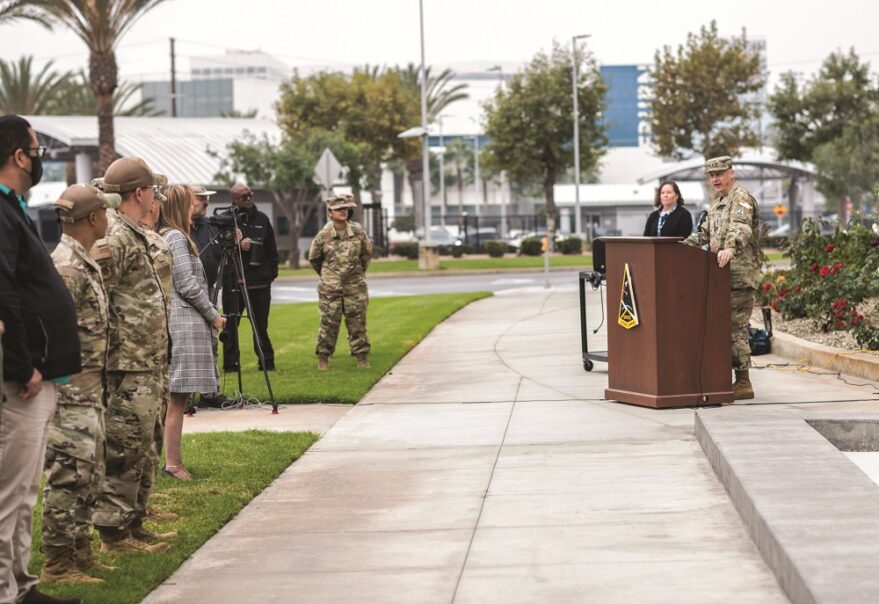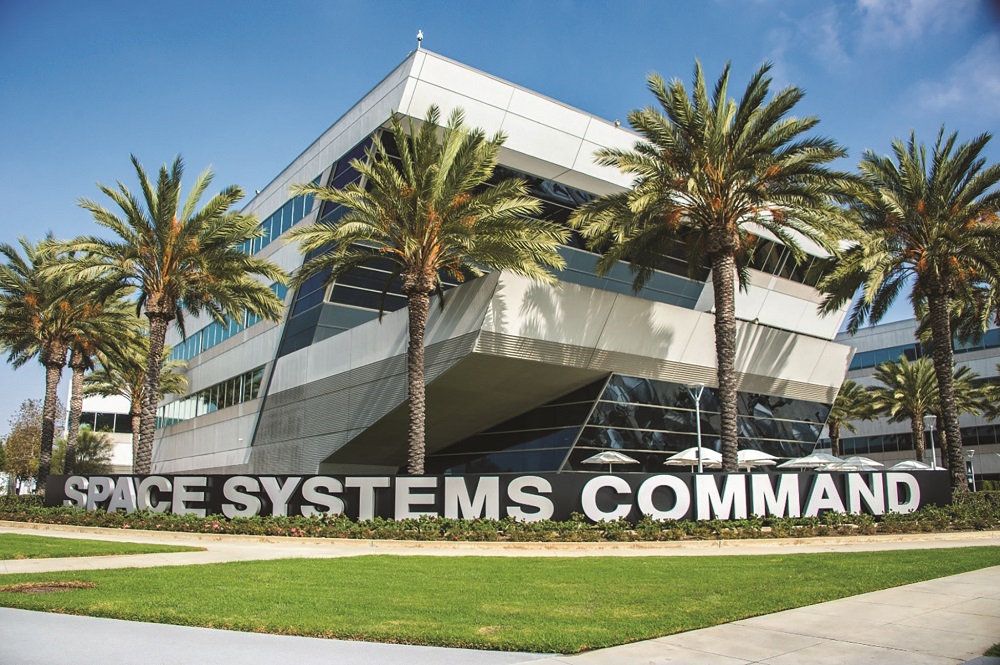U.S. Space Command last month opened a small office at the Catalyst Campus, a business park in Colorado Springs where more than 30 startups and defense contractors have set up shop.
Space Command, the U.S. military combatant command responsible for operations in outer space, tracks satellites and debris in orbit. Amid growing concerns about threats to U.S. spacecraft, the command wants swift access to technologies developed by companies at the campus, such as algorithms that analyze data on space objects to predict their path.
Accurate intelligence about the space domain is one example of the capabilities the U.S. military is looking to upgrade using commercially developed products. As the Pentagon prepares for the possibility that adversaries will target national and commercial satellites, the government’s ability to adopt commercial industry’s best technologies has become a major topic of discussion.
For decades the military has followed the traditional model of hiring defense contractors to develop custom-made satellites, sensors, ground stations and software. Meanwhile, private space companies using billions of dollars in venture capital are launching constellations at unprecedented speed, using artificial intelligence to analyze data and offering services that just a few years ago were only provided by government agencies.
The requirements-based acquisition system that is the norm today means the “ vast amount of DoD procurement dollars going exclusively to traditional vendors focused on bespoke government solutions with little, if any, commercial nexus,” said State of the Space Industrial Base 2021, a report published in November by the U.S. Space Force, the Defense Innovation Unit and the Air Force Research Laboratory.
The military has to “accelerate the adoption of commercial innovation,” said the report, noting that two-thirds of U.S. research and development investments today come from non-government sources. “If the U.S. is to retain its technological leadership and compete globally, it must diversify its portfolio and increase the total percentage of commercial procurements.”
SHIFT IN MINDSET
A key reason the military does business the way it does is that, historically, “we had to guarantee that capabilities would be there in a time of conflict,” Lt. Gen. Michael Guetlein, commander of the U.S. Space Force’s Space Systems Command, told SpaceNews.
For example, when the military was fighting wars in the Middle East and Afghanistan, it could not assume that the private sector would deliver all the needed services. “So we always had to have our own internal organic capabilities,” Guetlein said.
That mindset is evolving as the Space Force and Space Command take a broader view of providing space capabilities to military forces at sea, in the air and in the field, Guetlein said. “The innovation coming out of industry today is bringing an enormous amount of capability and opportunity to the table that we traditionally didn’t have,” he added. “I think we’re in a culture change with the stand up with the Space Force,” which was created to focus on the space domain and to bring fresh energy to acquisitions.
The Government Accountability Office, a congressional watchdog agency, cautioned in a recent report that the U.S. military is at risk of being outpaced by rival power China in space, cyber warfare and artificial intelligence.
“I think it’s important for Congress and DoD to continue to have this China pacing threat reality at the forefront of their thinking because business as usual for DoD is really a losing proposition,” said Cathleen Berrick, GAO’s managing director of defense capabilities. “This means they’re going to have to figure out how to adapt everything the department does away from the current industrial age approach to something more suitable for the information age.”
Over the past several years, DoD, the Air Force and the Space Force have launched efforts to build closer ties to the private sector, recognizing that much of the breakthrough innovation is happening outside the military-industrial base.
Former Defense Secretary Ash Carter in 2015 established the Defense Innovation Unit in Silicon Valley. DIU became an early supporter of emerging space launch companies like Rocket Lab, Virgin Orbit and Relativity Space, which were selected to launch experimental payloads.
The Air Force in 2017 created the Space Enterprise Consortium, known as SpEC, to attract commercial space startups and small businesses. The consortium awards contracts for prototypes of space systems, including satellites, payloads and ground systems. Joy White, executive director of the Space Systems Command, said the SpEC has grown to 644 companies, 477 of which are nontraditional firms.
Another effort started in 2017 was the Air Force technology accelerator known as AFWERX, created to help commercialize technologies and also serve national security needs. A space-focused spinoff, called SpaceWERX, was formed in 2020 and last year kicked off its first program, Orbital Prime, that seeks commercial solutions for debris removal and other on-orbit services.
BUYING COMMERCIAL SATS
The most visible push to bring commercial space technology into the military has come from the Space Development Agency, established in 2019. SDA is buying satellites, sensors and integration services from the commercial industry to build a military megaconstellation in low Earth orbit that could number close to 1,000 spacecraft by 2026.
The agency on Feb. 28 announced contracts worth nearly $1.8 billion to Lockheed Martin, Northrop Grumman and York Space Systems to build 126 satellites. The $382 million deal awarded to York Space for 42 satellites is a major victory for a 10-year-old company that had never won a large defense deal.
SDA later this year will be absorbed by the Space Force. Chief of Space Operations Gen. John “Jay” Raymond said the service over the next several years will start “to pivot significantly to a resilient architecture.” Resiliency means, for example, deploying proliferated constellations of large numbers of satellites and designing spacecraft with more advanced propulsion systems.
A recent white paper by the National Security Space Association, an industry group, said the private sector is eager to support national security programs but needs DoD to better inform the industry about its requirements.
“The national security space enterprise should collaborate with the private sector so that commercial companies are knowledgeable about its needs and requirements and invest to achieve specific desired and measurable defense or intelligence outcomes,” the paper said. “This dialogue could also convey government demand signals to influence commercial designs and investments.”
At the same time, said NSSA, the government has to learn how to be a smart buyer and “apply the basic rule of caveat emptor – buyer beware. “It must base procurement decisions on facts, markets, and business plans — not marketing or the latest faddish ideas.”

Preston Dunlap, the Space Force and Air Force chief architect, said there is a real desire to tap commercial space innovation, but that will require changes in procurement strategies and budget proposals.
Dunlap oversees the architecture of the Department of the Air Force’s nearly $70 billion of research, development and acquisition programs.
Many commercial space companies are winning contracts, but most are Small Business Innovation Research studies and demonstrations, not major procurements. “So we’ve got to be able to make sure we thread the needle,” Dunlap said last month at the SmallSat Symposium.
“We’ve got great partnerships across DIU and SDA and others,” he said, but many space projects are still experiments. They don’t quite get across the proverbial valley of death, a term used to describe the transition of technologies from research projects and prototypes to procurement programs with long-term funding.
“I’m seeing a twinkling of promise,” Dunlap said. “But we need to press start and get faster.”
To oversee military space procurement, President Biden in December selected former National Reconnaissance Office executive Frank Calvelli to be assistant secretary of the Air Force for space acquisition and integration. Once confirmed by the Senate, Calvelli will become the first-ever senior procurement executive in charge of military space programs, a post mandated by Congress in the 2020 National Defense Authorization Act.
During a confirmation hearing last month, Calvelli said the establishment of the Space Force “provided the Department of Defense a tremendous opportunity to take a fresh look at how to equip the force with new capabilities for the future fight.”
The commercial sector is at the forefront of many new technologies that underpin space systems, such as artificial intelligence, edge computing and machine learning, Calvelli said, adding that he will “work to identify and reduce the barriers to leveraging the best available commercial technologies.”
‘PICK THE BEST’
The cadre of defense contractors dominating the military space market has shrunk dramatically in a wave of mergers and acquisitions. The largest firms — Lockheed Martin, Raytheon, General Dynamics, Northrop Grumman and Boeing — collectively gobbled up 51 companies since the 1990s.
That sector stands in sharp contrast to the commercial space industry, where there is healthy competition, so there is an opportunity for the government to “pick the best,” said Josh Wolfe, co-founder and managing partner of Lux Capital, a venture fund that invests in defense and space companies.
Some of Lux Capital’s portfolio companies — Kymeta, Planet, Relativity Space and Orbital Insights, among others — compete in a DoD space market that is notoriously risk-averse and where it’s difficult to challenge incumbents, Wolfe said in an interview. However, there are signs that they are willing to try something new.
“Creating the Space Force was, I think, a net positive,” he said. While many people associate Space Force with the Netflix parody, “It’s not a joke. And I think people will take it seriously.”
Wolfe said the Space Force will come under increasing pressure to bring new technology to bear as rival nations exhibit advanced capabilities like anti-satellite weapons and hypersonic vehicles.
There is a flood of capital in the space industry and a wave of innovation that the government can ride on, he said. “They should put out solicitations for the best technology and they should award it to the best-performing companies. And those might not be the traditional big primes,” said Wolfe. “They should make room for the new entrants who might be able to deliver.”
“Investors are putting up meaningful equity capital” and “trying on our own dime to develop technology that we hope the government will buy,” said Wolfe.
“We just need to know that companies are going to get a fair shot to win the contracts and deliver. If they fail, they deserve to lose the contract,” he added. Military buyers “should set the expectation. The expectation should be vast, super high quality, low cost, and let the market do its thing.”
In the industry today, “you have a really motivated, high tech entrepreneurial engineering workforce that is delivering new capabilities,” said Wolfe. “They want to win and just need the chance.”
COMMERCIAL SERVICES
Steve “Bucky” Butow, director of the space portfolio at the Defense Innovation Unit, has long advocated for a shift in how DoD buys technologies.
Speaking on a panel at the SmallSat Symposium, Butow noted that the space industry is now offering an array of satellite-based services — imagery, analytics, weather data, broadband from low-Earth orbit constellations — that could be procured as an alternative to traditional acquisitions.
But other than satellite communications, “very few things in DoD land are bought as services,” he said.

An effort to start buying space industry services is now underway at Space Systems Command. Guetlein said a new office focused on the procurement of commercial services recently opened in the Washington, D.C., area. This new organization will assess opportunities to buy, for example, satellite imagery, weather and space domain awareness data as a service. “It is intended to be a one-stop shop,” he said.
The next step is to develop a business plan for military users to fund these services. Guetlein said SSC is working with the Pentagon to create a working capital fund where military customers allocate money for space services. “We’re hoping we can put in place a working capital fund for all commercial services,” he added.
Joseph Rouge, Space Force deputy director of intelligence, surveillance and reconnaissance, said there is a growing demand across the military for imagery and other data as a service from low Earth orbit satellite operators.
The question was posed by Air Force Secretary Frank Kendall: “How are we going to use commercial capabilities,” Rouge said at a recent ExecutiveBiz forum.
Most of the satellite imagery used by the military comes from U.S. intelligence satellites operated by the NRO or from the NRO’s commercial providers. But battlefield commanders have growing demands for more specialized and timely ISR services.
One way to support these needs is being proposed by the Space Development Agency, which is discussing agreements with commercial imagery providers to transfer data directly from their satellites to SDA’s through optical intersatellite links.
There are many options to work with industry, but it takes some imagination, Rouge said. “In government, we have gotten used to defining a requirement. We go out to industry and say, okay, industry, can you give us that solution?”
What DoD needs to do instead is “work with industry to figure out how their innovation can be utilized by us, in addition to telling them what we need,” Rouge said. “This requires us to have a very good understanding of what commercial technology and innovation can do for us. And it requires dialogue.”
Claude Rousseau, a space industry consultant at Northern Sky Research, said governments are missing out on commercial space advances due to the complexities of requirements and their focus on process rather than outcomes, “which is a peculiar way to do business.”
The industry is pushing for more initiatives like the NRO’s recent data-sharing agreements with commercial radar satellite operators Airbus, Capella Space, Iceye, PredaSAR and Umbra. “That helps space businesses get solid feedback from a demanding customer, so they can then turn around and say to prospective investors they’ve got a real government customer that likes their product,” Rousseau said.
One way for commercial space companies to get a foot in the door and learn about the defense market is to talk directly to military users, said Kari Bingen, chief strategy officer of HawkEye360, a commercial remote sensing satellite operator.
“You need to build trust, and it starts with the relationship,” Bingen said at the SmallSat Symposium. HawkEye360, for example, provides data to the military for use during exercises or experiments, and company officials work side-by-side with the military users of the data. This helps them understand “what commercial providers can do and, importantly, what they can’t do,” she said.
“This also gives the commercial folks a better insight into what exactly are the problems that they [the military] are trying to solve,” Bingen said. “I can think of a couple of times when we went in thinking that we understood the government’s problem, but once we got into a combatant command, it was very different from what we anticipated.”
At the Catalyst Campus in Colorado, software engineers and programmers from commercial firms work alongside Space Command officials to improve what the military calls space domain awareness.
“We need to understand what’s happening,” said Lt. Gen. John Shaw, U.S. Space Command deputy commander. He described space domain awareness as a “big data problem” that can’t just be fixed with more sensors but requires advanced analytics to make sense of the raw data.
The Space Systems Command has similar collaborative workspaces in Los Angeles, said Guetlein. “We want to build a partnership environment, where industry can come in, and we can help them understand how to do business with the government. We can connect them to the operator so they can understand what we’re trying to solve.”
These are positive steps, but more needs to be done, argues the National Security Space Association. “Mechanisms like the Defense Innovation Unit and Catalyst Campus are useful means of discovering and accessing innovation. While they have improved the government’s ability to scout talent, the scaling and ‘valley of death’ challenges remain.”
This article originally appeared in the March 2022 issue of SpaceNews magazine.
